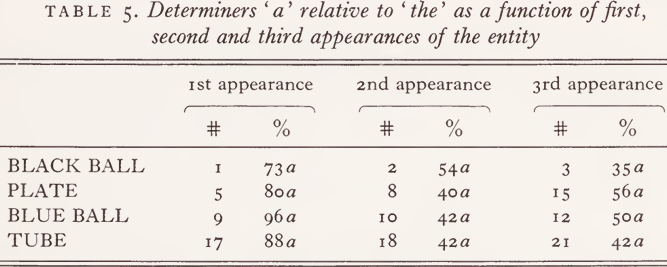


 Grammar
Grammar
 Tenses
Tenses
 Present
Present
 Past
Past
 Future
Future
 Parts Of Speech
Parts Of Speech
 Nouns
Nouns
 Verbs
Verbs
 Adverbs
Adverbs
 Adjectives
Adjectives
 Pronouns
Pronouns
 Pre Position
Pre Position
 Preposition by function
Preposition by function 
 Preposition by construction
Preposition by construction
 Conjunctions
Conjunctions
 Interjections
Interjections
 Grammar Rules
Grammar Rules
 Linguistics
Linguistics
 Semantics
Semantics
 Pragmatics
Pragmatics
 Reading Comprehension
Reading Comprehension|
Read More
Date: 2023-11-15
Date: 2024-08-23
Date: 11-2-2022
|
Sampson (1969) suggests that there are two major types of noun phrases, ‘establishing’ and ‘re-identifying’, these being obviously related to the grammarian’s distinction between Indefinite and Definite. When one says I bought a red car yesterday, this, according to Sampson, is an instruction to the listener to add a new referent to his stock; but when one says I bought the red car yesterday, this represents an attempt by the speaker to single out an already existing referent (presupposed) in the listener’s mind. Sampson then proceeds to criticize those linguists who have treated this distinction as if it were a semantic feature, particularly Carlota Smith (1964) who maintained that definiteness is actually a semantic gradient. My data on perceptual presuppositions clearly supports Smith’s view. However, the determination of a vs. the is complicated by another type of presupposition - namely, whether or not the entity represented by the noun phrase is a member of a set ( a white chip) or unique (the blue chip). A familiar entity which is perceived as a member of a set will still be accorded the indefinite status with a, as in #30 (THE MAN TAKES A WHITE CHIP) after the WHITE CHIPS have already been ‘ established ’ as a referent. I shall use the more general (psychologically) terms ‘identifying’ (for the indefinite condition) and ‘recognizing’ (for the definite condition), thereby eliminating the listener as a necessary condition.
To determine the effect of entity repetition upon choice of determiner, I selected four entities which had repeated appearances in perceptual events, BLACK BALL, PLATE, BLUE BALL and TUBE. Table 5 gives the percentage of indefinite a to total determiners (i.e., the percentage of definite the is the value given subtracted from 100). First, we may note the sharp drop in % indefinite from first appearance to all subsequent appearances; second, we note that any interval filled with perceived events not involving the entity in question tends to produce an increase in the probability of the indefinite a (e.g., demonstrations #8 to #15 for second and third appearances of PLATE). The BLACK BALL, having appearances in demonstrations #1, #2 and #3 provides the purest test of the gradient hypothesis. This gradient in determination of determiners suggests that this is the general condition for semantic feature coding, with discrete, binary coding being a special case.

The influence of perceived uniqueness vs. membership in a set of entities is clearly indicated by comparing # 29 (THE MAN TAKES THE BLUE CHIP) and #31 (THE MAN TAKES THE MIDDLE CHIP) with #30 (THE MAN TAKES A WHITE CHIP).1 The uniquely perceived entities produce only 48 %a (#29) and 29 %a (#31), whereas the member of a set (ONE OF THE WHITE CHIPS IN THE RING) produces 100 % indefinite a (if we exclude one of the and one) - there were 57 %a and o % the with transforms involving one excluded.
1 Events #29 through #31 involved a circle of chips, mostly white but including one blue and one red, with a single white chip in its middle.
|
|
|
|
دراسة تحدد أفضل 4 وجبات صحية.. وأخطرها
|
|
|
|
|
|
|
جامعة الكفيل تحتفي بذكرى ولادة الإمام محمد الجواد (عليه السلام)
|
|
|